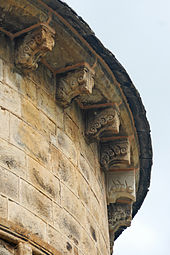Chipboard crag (architecture)




Chipboard crags are carved stone consoles as constructive and creative components of eaves . They are an architectural feature of the Auvergne Romanesque churches .
Corbels consist of the outer visible part, which is tapered horizontally at the top and tapering upwards on the underside, and an invisible part, which is built into the upper edge of the outer walls. The cantilever width results from the material and the intended eaves overhang, their distances from one another from the expected load. The rear gaps can simply be smoothly bricked, but also designed with stones of different shapes and colors or with incrustations . On the corbels there are mostly flat cornice panels , the visible edges of which are profiled or structured from plain to elaborate. Their undersides can be smooth, but they can also be decorated with reliefs .
The rafter heads of the wooden roof construction end on them , which in turn support the roof covering by means of roof battens. In the Romanesque period, this mainly consists of hollow roof tiles in Roman form, which are also called monk-nun tiles . These protrude over the front edge of the cornice panels so that the rainwater can drip off. With a few exceptions, planar chipboard bricks are always used in a continuous row with absolutely the same shape. Their cantilever widths can differ for the individual components. The sculpture of the planed cantilevered stones usually makes the highest demands on the sculptor in terms of craftsmanship , as it is very profound and delicate. Due to the permanent repetition of the motif, planed chipboard bricks appear unimaginative and monotonous to the less informed observer.
The planed chipboard got its name from the round sleeves on both sides of the cantilever, which look like the shavings that roll up when planing wood . Viewed from the side, it has an angularly bent plate on the inside and on the top, which seems to lie against the components. Their visible edges are finely profiled.
Viewed from the front, there is a thick, vertical plate exactly in the middle from which the wood shavings protrude to the side. Its edge is also profiled and, viewed from the side, runs from bottom to top in a slightly inwardly curved curve, which the wood shavings also follow. It can be found widespread in Auvergne, especially on the eaves of the main Limagne churches ( Clermont-Ferrand , Auvergne).
The art historian Viollet-le-Duc documented the cantilever brackets from the 11th to the 15th centuries, and in particular the chipboard bricks with excellent graphics. He explains the origin of the wood shavings using a model of such a corbel made of wood, in which the shavings are shown particularly clearly. He also supplements these sculptures with specialist texts.
Web link
- Viollet-le-Duc : Dictionnaire raisonné de l'architecture française du XIe au XVe siècle Paris 1868. Vol. 4. Corbeau. Online at Wikisource Descriptions and Graphics of Corbels


